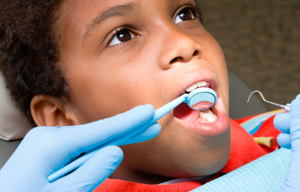The Healthy Schools Campaign originally published this blog post on improving attendance through an innovative practice known as teledentistry.
A terrible toothache is virtually impossible to ignore. For millions of children across the nation, the consequences of untreated tooth decay extend far beyond momentary pain to include potentially devastating effects on their long-term learning and opportunity.
Now, a new approach called teledentistry offers the promise of addressing this issue and relieving the lifelong burden it places on young children.
Dental Health Affects Learning and Opportunity
Persistent pain, along with related trouble eating and sleeping, makes oral health one of the leading causes of chronic school absenteeism among young students. A full 20 percent of children aged 5 to 11 years have at least one untreated decayed tooth. Among school-age children, tooth decay is the most common chronic disease, five times more prevalent than asthma. Children between 5 and 17 years miss nearly two million school days in a single year nationwide due to dental health-related problems.
This, in turn, can have a significant impact on students’ lifelong opportunity. For example, research shows that children who are chronically absent in both kindergarten and first grade are much less likely to be reading at grade level by the third grade; and students who are not reading at grade level by the third grade, in turn, are four times more likely to drop out of high school.
The tremendous scale of these consequences is especially poignant because dental health problems are so often preventable and easily treatable with access to primary dental care. Barriers related to cost, transportation, language and other logistics, however, have put this basic care out of reach for millions of U.S. children.
TeleDentistry Brings Care to the Community
Now, a new program is removing these barriers with powerful results for children’s health and practical savings for the health care system.
By leveraging familiar technology and a practical, cost-effective model called teledentistry, innovative care providers are bringing high-quality dental services to children in the school setting.
The result: Students get the care they need to stay in class and learn. Emergency room visits and complex, costly treatments (often paid for by Medicaid or related state-run programs) are replaced by effective and low-cost preventive care.
Teledentistry utilizes the technology widely used in dentists’ offices, such as X-ray machines, with the added advantage that this technology has become more precise and more portable than ever and is therefore now practical in community settings such as schools.
Specially trained dental health professionals — most often dental hygienists who have taken part in additional professional development — are deployed to community sites to provide preventive care and basic treatments with a set of tools and technologies that essentially constitute a portable pop-up clinic. They take X-rays, provide professional cleaning, apply sealants and fluoride treatment, and also apply interim therapeutic restorations, a technique that alleviates the pain and limits the spread of a cavity until the student can see a dentist. They also provide education on oral hygiene and nutrition as it relates to oral health. These dental professionals work closely with supervising dentists to identify more complex problems and develop ongoing treatment plans.
The Pacific Center for Special Care and The Children’s Partnership, who collaborated on a successful teledentistry demonstration program in California, explain in their fact sheet:
Typically, a dental hygienist will bring a portable dental chair, a laptop computer, a digital camera, and a handheld X-ray machine—which, together, can all fit into the trunk of a car—to a site such as a preschool, elementary school, or community center. Within minutes, children and others who need care are getting state-of-the-art diagnostic, preventive, and early intervention dental care.
Meanwhile, dentists are able to stay in their clinics and focus primarily on addressing the most advanced and complex needs of patients. From their clinics, dentists also play a role in the care delivered in the community: They review X-rays, assess care needs and develop treatment plans while supervising the dental professionals who provide front-line care in the community.
Teledentistry has proven to be so effective in part because of the improvements in technology we’ve seen in recent years. Yogita Thakur, who served as dental director for one of the sites in the California demonstration program, explained: “Think about how far we have come in the resolution of digital images in the last ten years. In many cases, digital imagery is providing us a clearer look into the patient’s mouth than we can get with our own two eyes.”
When more complex care is needed, the community dental professionals arrange for such care to be provided in the community setting or can organize a follow-up appointment in the dentist clinic. (Importantly, they can also work with the school to help address barriers that students may face in making it to the appointment.) The demonstration program found that about two-thirds of children can achieve and maintain good dental health with care provided in the community setting.
Improved Dental Health = Fewer Missed School Days
By making preventive care and basic treatment accessible in schools, teledentistry removes one of the most significant barriers children face to good attendance and academic success. The consequences are profound for children’s education and for their lifetime health.
The good news is that the practical nature and demonstrated positive results of teledentistry are capturing the attention of policymakers, the public health community and leaders in the dentistry sector. The state of California, for example, recently adopted legislation that will help expand teledentistry to underserved populations across the state.
Expanding teledentistry to increasing numbers of students holds great promise in efforts to combat health-related chronic absenteeism on a large scale, with huge rewards for children’s health and lifetime opportunity.
Learn more about teledentistry and specifically about the results of the Pacific Center for Special Care and The Children’s Partnership demonstration project here.